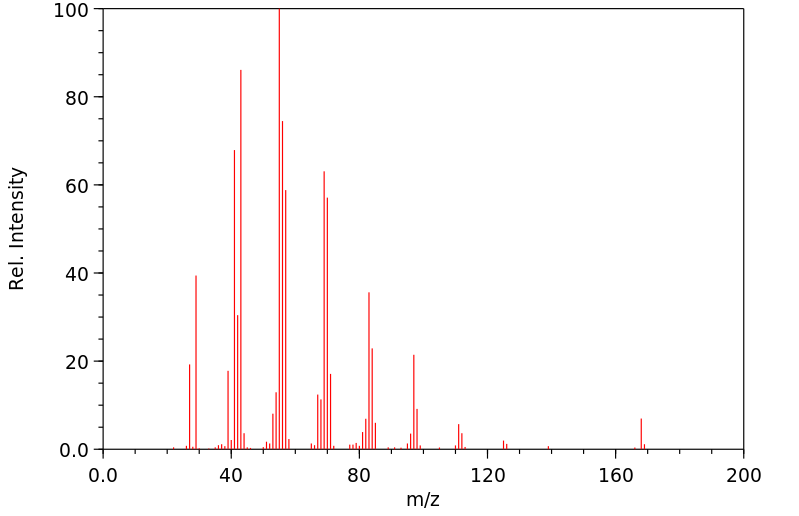(2E)-2-十二碳烯 | 7206-13-5
中文名称
(2E)-2-十二碳烯
中文别名
2-十二烯
英文名称
(E)-2-dodecene
英文别名
(E)-dodec-2-ene
CAS
7206-13-5
化学式
C12H24
mdl
——
分子量
168.323
InChiKey
ADOQBZAVKYCFOI-HWKANZROSA-N
BEILSTEIN
——
EINECS
——
-
物化性质
-
计算性质
-
ADMET
-
安全信息
-
SDS
-
制备方法与用途
-
上下游信息
-
文献信息
-
表征谱图
-
同类化合物
-
相关功能分类
-
相关结构分类
物化性质
-
熔点:-38.4°C (estimate)
-
沸点:207.3°C (estimate)
-
密度:0.7761 (estimate)
-
LogP:6.412 (est)
-
保留指数:1202;1202;1202;1203;1201;1197
-
稳定性/保质期:
- 存在于烟气中。
- Z、E构型未确定,上述基本参数指(E)-2-十二烯。
计算性质
-
辛醇/水分配系数(LogP):6.5
-
重原子数:12
-
可旋转键数:8
-
环数:0.0
-
sp3杂化的碳原子比例:0.83
-
拓扑面积:0
-
氢给体数:0
-
氢受体数:0
SDS
上下游信息
-
上游原料
中文名称 英文名称 CAS号 化学式 分子量 1-十二烯十二碳烯α-十二碳烯α-十二碳烯 1-dodecene 112-41-4 C12H24 168.323 正癸烯 1-Decene 872-05-9 C10H20 140.269 —— (E,E)-1,12-dibromo-2,10-dodecadiene 72312-59-5 C12H20Br2 324.099
反应信息
-
作为反应物:描述:(2E)-2-十二碳烯 在 正丁基锂 、 二苯硫醚 、 potassium tert-butylate 作用下, 以 四氢呋喃 、 正己烷 为溶剂, 反应 5.0h, 生成 (E)-(dodec-2-enyl)trimethylsilane参考文献:名称:Franzini, Livia; Moret, Etienne; Schlosser, Manfred, Chemische Berichte, 1997, vol. 130, # 1, p. 83 - 87摘要:DOI:
-
作为产物:描述:1-十二烯十二碳烯α-十二碳烯α-十二碳烯 在 disodium tetracarbonylferrate 、 copper(l) chloride 作用下, 以 四氢呋喃 为溶剂, 反应 12.0h, 以80%的产率得到(2E)-2-十二碳烯参考文献:名称:Isomerization of 1-alkenes using the Na2Fe(CO)4/CuCl and Na2Fe(CO)4/BrCH2CH2 Br reagent systems摘要:The reagent Na2Fe(CO)(4) prepared in situ in THF by the reduction of Fe(CO)(5) with sodium naphthalenide reacts with certain alkenes in the presence of CuCl to bring about isomerization of the alkenes. Thus the 1-alkenes (1-dodecene, 1-decene, safrole and allyl benzene) are isomerized to trans-2-alkenes, and beta-pinene is isomerized to alpha-pinene. Reactions involving BrCH2CH2Br in place of CuCl give similar results.DOI:10.1016/0022-328x(94)05243-5
文献信息
-
METHOD FOR SYNTHESIZING SODIUM 2,2,6,6-TETRAMETHYLPIPERIDIDES申请人:KOBELCO ECO-SOLUTIONS CO.,LTD.公开号:US20190359571A1公开(公告)日:2019-11-28There is a demand for the development of a technique according to which sodium 2,2,6,6-tetramethylpiperidides (Na-TMPs) can be economically and efficiently synthesized through simple operations including a small number of steps under mild conditions in a short period of time. Also, there is a demand for the development of a technique according to which high-quality Na-TMPs that do not contain lithium or lithium compounds such as Li-TMP can be synthesized. The method for synthesizing sodium 2,2,6,6-tetramethylpiperidides includes a step of obtaining sodium 2,2,6,6-tetramethylpiperidides by reacting, in a reaction solvent, 2,2,6,6-tetramethylpiperidines with a dispersion product obtained by dispersing sodium in a dispersion solvent or an organosodium compound having an aromatic ring obtained through a reaction with a dispersion product obtained by dispersing sodium in a dispersion solvent.有一种需求,即开发一种技术,通过简单操作,包括在温和条件下,短时间内进行少量步骤,经济高效地合成钠2,2,6,6-四甲基哌啶衍生物(Na-TMPs)。此外,还需要开发一种技术,用于合成不含锂或锂化合物(如Li-TMP)的高质量Na-TMPs。合成钠2,2,6,6-四甲基哌啶衍生物的方法包括一个步骤,即通过在反应溶剂中使2,2,6,6-四甲基哌啶与分散溶剂中分散的钠的分散产物或通过与分散溶剂中分散的钠的分散产物反应得到的含有芳香环的有机钠化合物反应,从而获得钠2,2,6,6-四甲基哌啶衍生物。
-
<i>Z</i>-Selective Alkene Isomerization by High-Spin Cobalt(II) Complexes作者:Chi Chen、Thomas R. Dugan、William W. Brennessel、Daniel J. Weix、Patrick L. HollandDOI:10.1021/ja408238n日期:2014.1.22rare, because the more stable E-isomers are typically formed. We show here that cobalt(II) catalysts supported by bulky β-diketiminate ligands have the appropriate kinetic selectivity to catalyze the isomerization of some simple 1-alkenes specifically to the 2-alkene as the less stable Z-isomer. The catalysis proceeds via an "alkyl" mechanism, with a three-coordinate cobalt(II) alkyl complex as the简单的末端烯烃异构化为具有 Z 立体化学的内部异构体的情况很少见,因为通常会形成更稳定的 E 异构体。我们在这里表明,由庞大的 β-二酮亚胺配体支撑的钴 (II) 催化剂具有适当的动力学选择性来催化一些简单的 1-烯烃的异构化,特别是作为稳定性较差的 Z-异构体的 2-烯烃。催化通过“烷基”机制进行,三配位钴 (II) 烷基配合物作为静止状态。如同位素标记实验所示,β-氢化物消除和 [1,2]-插入步骤都很快。立体模型通过在 β-氢化物消除的过渡态钴 (II) 处的方形平面几何结构来解释选择性。该催化剂不仅适用于简单的烯烃,还适用于高烯丙基硅烷、缩酮、和甲硅烷基醚。从与不良底物的反应中分离出钴 (I) 或钴 (II) 产物表明,关键的催化剂分解途径是双分子的,降低催化剂浓度通常会提高选择性。除了潜在有用的选择性转化之外,这些研究还为高自旋钴配合物催化烯烃异构化提供了机理理解,并证明了空间体
-
Nonredox Metal-Ion-Accelerated Olefin Isomerization by Palladium(II) Catalysts: Density Functional Theory (DFT) Calculations Supporting the Experimental Data作者:Ahmed M. Senan、Shuhao Qin、Sicheng Zhang、Chenling Lou、Zhuqi Chen、Rong-Zhen Liao、Guochuan YinDOI:10.1021/acscatal.6b01061日期:2016.7.1Redox metal-ion-catalyzed olefin isomerization represents one of the important chemical processes. This work illustrates that nonredox metal ions can sharply accelerate Pd(II)-catalyzed olefin isomerization, while Pd(II) alone is very sluggish. Nuclear magnetic resonance (NMR) and ultraviolet–visible light (UV-vis) characterizations disclosed that the acceleration effect originates from the formation
-
Nitrogen-Doped Carbon-Encapsulated Nickel/Cobalt Nanoparticle Catalysts for Olefin Migration in Allylarenes作者:Søren Kramer、Jerrik Mielby、Kasper Buss、Takeshi Kasama、Søren KegnaesDOI:10.1002/cctc.201700316日期:2017.8.9homogeneous catalysts. In contrast, very limited progress has been made with the use of cheap, Earth‐abundant base metals as heterogeneous catalysts for these transformations—in spite of the obvious economic and environmental advantages. Herein, we report on the use of an easily prepared heterogeneous catalyst material for the migration of olefins, in particular, for allylarenes. The catalyst material
-
Highly <i>Z</i>-Selective Double Bond Transposition in Simple Alkenes and Allylarenes through a Spin-Accelerated Allyl Mechanism作者:Daniel Kim、Guy Pillon、Daniel J. DiPrimio、Patrick L. HollandDOI:10.1021/jacs.1c00856日期:2021.3.3Double-bond transposition in alkenes (isomerization) offers opportunities for the synthesis of bioactive molecules, but requires high selectivity to avoid mixtures of products. Generation of Z-alkenes, which are present in many natural products and pharmaceuticals, is particularly challenging because it is usually less thermodynamically favorable than generation of the E isomers. We report a β-dialdiminate-supported烯烃中的双键转座(异构化)为生物活性分子的合成提供了机会,但需要高选择性以避免产物混合。的代ž链烯烃,其存在于许多天然产物和药物,尤其具有挑战性,因为它比产生的一般较少热力学有利的是Ë异构体。我们报告了一种 β-二二二胺支持的高自旋钴 (I) 配合物,它可以将末端烯烃(包括以前顽固的烯丙基苯)转化为Z-2-烯烃具有前所未有的高区域选择性和立体选择性。氘标记研究表明,该催化剂通过 π-烯丙基机制起作用,这与其他Z-选择性催化剂遵循的烷基机制不同。计算表明,三重态钴 (I) 烯烃配合物在最低能量 C-H 活化过渡态中经历了从静止态三重态到单重态的自旋态变化,这导致了Z产物。这表明自旋状态的这种变化使催化剂能够区分该系统中的立体定义障碍,更一般地说,自旋状态的变化可能为第一行过渡金属的新型立体控制方法提供了一条途径。
表征谱图
-
氢谱1HNMR
-
质谱MS
-
碳谱13CNMR
-
红外IR
-
拉曼Raman
-
峰位数据
-
峰位匹配
-
表征信息
同类化合物
高密聚乙烯
香叶醇
顺式3-甲基-2-己烯
顺式-5-癸烯
顺式-5-甲基-2-己烯
顺式-5-庚烯-1-炔
顺式-4-癸烷
顺式-4-甲基-2-戊烯
顺式-4-甲基-2-戊烯
顺式-3-癸烯
顺式-3-甲基-3-己烯
顺式-3-甲基-2-庚烯
顺式-3-戊烯-1-炔
顺式-3,4-二甲基-3-己烯
顺式-3,4-二甲基-2-戊烯
顺式-3,4-二甲基-2-戊烯
顺式-2-甲基-3-己烯
顺式-2-壬烯
顺式-2-丁烯-D1
顺式-1.1.1-三甲基-2-丁烯
顺式-1-甲基-2-环丙基乙烯
顺式-1-甲基-2-乙烯基环戊烷
顺式-1-环戊基-1-辛烯
顺式-1-氘代-3-甲基-1-丁烯
顺式-(9ci)-2,3,3a,7a-四氢-4-(1-甲基乙基)-1H-茚
顺式-(2-丁烯基)环丙烷
顺式,顺式-2,4-己二烯
顺-环辛烯
顺-9-二十一碳烯
顺-6-十三碳烯
顺-5-甲基-1,3,6-庚三烯
顺-4-辛烯
顺-4-壬烯
顺-3-辛烯
顺-3-甲基-2-戊烯
顺-3-壬烯
顺-3-十三碳烯
顺-2-辛烯
顺-2-癸烯
顺-2-戊烯
顺-2-庚烯
顺-2-己烯
顺-2-丁烯
顺-2,2-二甲基-3-己烯
顺-1,3-戊二烯
顺,顺-1,9-环十六烷二烯
顺,顺,顺-环癸-1,3,5-三烯
间戊二烯
间二(4-吡啶基)苯
镁,二-2-丁烯基-







